Beaches Tidings Fall 2017
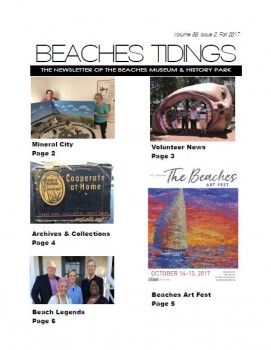
The Fall 2017 issue of Beaches Tidings, The Newsletter of the Beaches Museum & History Park, is now available. Click here to read this edition of Beach Tidings.


The Fall 2017 issue of Beaches Tidings, The Newsletter of the Beaches Museum & History Park, is now available. Click here to read this edition of Beach Tidings.
Shrimping and Fishing in Mayport
This article is an excerpt from the 2016 exhibit, Mayport Village: On the River of Change.
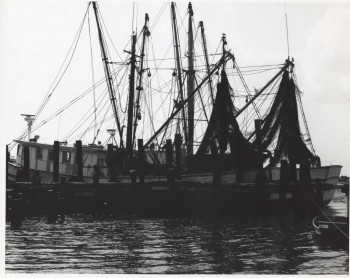
Commercial fishing and shrimping operations have played an integral role in shaping life in Mayport Village for over one hundred and fifty years. Home to some of the oldest shad fisheries in Florida, the industry has experienced several transformations as technology and infrastructure has evolved.
In the 1850s, New England fishermen discovered the mouth of the St. Johns River was teeming with shad, mullet, alewives, and other marine species that relied on fresh water for feeding and spawning. By the 1870s, several Connecticut-based boat captains, including Captain David Kemps, Sr. relocated to the Mayport Village area to make a living. Deploying shad-nets, mullet-nets, haul-seines and gill-nets, they fished alongside expert African-American fishermen who were chiefly responsible for the fisheries’ daily operations. More than three-fourths of the catch was sold to dealers in Savannah.
By the early 1900s, mullet and shad populations dropped dramatically. Mayport captains attributed this to the unrestricted use of gill-nets and the increasing presence of steamboats in the river.
New opportunities arose in shrimping, however, by the 1920s. The advent of motorized fishing vessels made offshore shrimping a feasible and lucrative venture. The arrival of experienced Portuguese fishing families, the Rowlands and the Perrys, that same decade breathed life into a nascent industry.
By the 1950s, shrimp docks dominated the horizon of Mayport. Local men like Johnny Vona, Booty Singleton, Mathias “Matt ” Roland, Mr. Parnell, Manuel Jesus, Jesse Perry, and A.J. Ruffin were the backbone of the industry. Two decades later, more than 150 shrimping vessels were unloading their catch at Mayport Village docks. Nearly everyone in the village had a shrimper in their family. A popular local pastime was to greet the boats as they entered the village to see the day’s catch.
The late 1990s and early 2000s, however were unkind to the once-bustling shrimping fleet. Local shrimpers credit rising gas-prices and foreign imports of Ecuadorian and Asian shrimp for the industry’s decline. Today, Safe Harbor Seafood is the last remaining dock open for commercial offload.
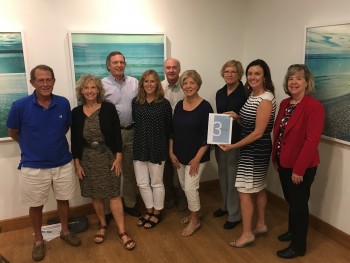 The Beaches Museum & History Park’s Board of Directors started its 2017-2018 year strong with the presentation of its new Strategic Plan. The 10-month process was supported by the Community Foundation and was facilitated by Jana Ertrachter, the Ertrachter Group, who brought years of experience guiding organizations through the Strategic Planning Process.
The Beaches Museum & History Park’s Board of Directors started its 2017-2018 year strong with the presentation of its new Strategic Plan. The 10-month process was supported by the Community Foundation and was facilitated by Jana Ertrachter, the Ertrachter Group, who brought years of experience guiding organizations through the Strategic Planning Process.
A 12-member team comprised of board members, staff, volunteers and community members met monthly to gather and share information, derive key strategic issues and to assemble the roadmap for the Museum’s next three years.
Among other things, the group proposed new mission, vision and values statements that were unanimously adopted by the board at their October 10 meeting. The new mission statement of the Museum is “To preserve and share the distinct history and culture of the Beaches area”.
In addition to presenting the Strategic Plan, the new officers and two new members were announced. 2017-2018 officers will be: President-Jack Schmidt, Vice President-Linda Lanier, Treasurer-Randy Hayes and Secretary-Bill Carter. The board welcomed Chris Pilinko and Claudia Estes.
“We have a busy year of interesting programming, engaging special events and even more initiatives to share the fascinating history of our community” says Jack Schmidt, Board President. “Having the right board, volunteers and staff in place are key to making all of our endeavors a success and we look forward to a great year”.
Please visit Our Mission page to learn more about the Beaches Museum’s Vision, Values, and to review a complete copy of the Strategic Plan.
Admission to the Beaches Museum is free and information about programs and events can be found by calling 904-241-5657.
Charlie Holbert was having dinner with his wife and two young sons on Wednesday, Sept. 27, 1967, when he first heard the roar of an approaching airplane flying dangerously low over his home in the Ocean Forest section of Jacksonville Beach.
The Southern Bell traffic engineer ran outside just in time to catch a fleeting glimpse of a U.S. Navy plane struggling to stay aloft in the rapidly disappearing daylight. Holbert’s three-bedroom house was within easy walking distance of the Intracoastal Waterway where the crippled plane seemed to be heading. Seconds later, he heard “the sickening sound” of the plane crashing into the nearby mud flats.
Forty-five years later, after reading a retelling of the crash in The Beaches Leader, Holbert came to the realization that he and his family may actually owe their lives to the heroic actions of the pilot of that ill-fated maritime patrol plane, Lt. Michael P. Myers.
Seconds earlier, the aircraft had collided with a Navy jet that had lost radio contact with its Mayport-based aircraft carrier, the USS Shangri-La. The mid-air collision, which occurred around 6:30 p.m., took the lives of six servicemen: five in the patrol plane and one in the F-8 Crusader jet. Many believe the 30-year-old Myers deliberately ditched his aircraft into the river to avoid any collateral damage on the ground.
After clipping the tail section of Myers’ plane, which was headed south to NAS Jacksonville, the Navy jet plunged into the Intracoastal, its lone occupant, Lt. (j.g.) Mark E. Garrett of Light Photographic Squadron 82 of NAS Cecil Field, still strapped into the cockpit. An airman permanently assigned to Myers’ plane gave up his seat on the twin-engine turboprop so 19-year-old Philip R. Huggins could get some flight time. Also killed were radioman Marion E. Young, 25, and Lt. Cmdr. R.H. Ford, 33, a Naval Reserve co-pilot on a two-week active-duty assignment. “It was a sad experience to see so many friends lost that day,” recalled the airman whose life was spared.
Holbert wasn’t the only eyewitness to history. Nancy Broner was at Fletcher High’s football stadium cheering for her junior high classmates when she noticed something alarming in the sky overhead. “Those planes are going to collide,” Broner recalled in 2012. “One of them went nose down.”
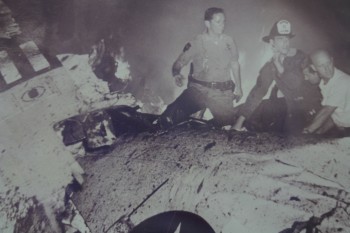 Rush Abry, a well-known Beaches photographer, managed to capture the only image of the crash site after wading through chest-high water to reach a tiny island where the patrol plane crashed and burned upon impact. His stunning black-and-white photo of four first-responders straddling the plane’s crumpled fuselage as a fire blazes behind them won a state press award for on-the-spot photography.
Rush Abry, a well-known Beaches photographer, managed to capture the only image of the crash site after wading through chest-high water to reach a tiny island where the patrol plane crashed and burned upon impact. His stunning black-and-white photo of four first-responders straddling the plane’s crumpled fuselage as a fire blazes behind them won a state press award for on-the-spot photography.
Abry’s waterfront home in Jacksonville Beach overlooks the marsh and the scene of the crash. A few years ago, the widow of Charles M. McLarty, a 26-year-old crewman on the aircraft, traveled to Jacksonville Beach to pay homage to her late husband. She and Abry posed for a picture on the back patio of Abry’s home with the island hauntingly looming in the background. Shortly after the tragic accident, Sheila McLarty (now Moore) and Lt. Myers’ widow, Jeanne Hand, invited Lt. Garrett’s widow, Linda, to dinner. Each had suffered a tremendous loss, but their friendship didn’t suffer because of it. Recalled Hand 45 years later: “I wanted Linda to know that we were not upset with her, and that there were no hard feelings.”
This article is an excerpt from the 2017 exhibit, Atlantic Beach: From the Continental to a Coastal Community.
 The unique and memorable buildings of Atlantic Beach have greatly contributed to the character of this community throughout its life. The Continental Hotel – a monumental structure built at a time when there were almost no other buildings around – set the tone for the future of the community. The people who shaped Atlantic Beach in its early days hoped to form a more upscale community that drew in more elite residents. From converted carriage houses to a “hobbit house,” this trend has led to some of the most unique structures in the Beaches communities. The buildings mentioned below are just a few examples of the architecture found in Atlantic Beach throughout the years.
The unique and memorable buildings of Atlantic Beach have greatly contributed to the character of this community throughout its life. The Continental Hotel – a monumental structure built at a time when there were almost no other buildings around – set the tone for the future of the community. The people who shaped Atlantic Beach in its early days hoped to form a more upscale community that drew in more elite residents. From converted carriage houses to a “hobbit house,” this trend has led to some of the most unique structures in the Beaches communities. The buildings mentioned below are just a few examples of the architecture found in Atlantic Beach throughout the years.
 The Bull House. Built around 1902, this house represented some of the earliest construction in Atlantic Beach. The home of several members of the Bull family over the years, it was a longtime landmark in Atlantic Beach.
The Bull House. Built around 1902, this house represented some of the earliest construction in Atlantic Beach. The home of several members of the Bull family over the years, it was a longtime landmark in Atlantic Beach.

Echidna. Named after the spiny mammals of the same name from Australia, the house was built in 1937 by Hayden W. Crosby of Jacksonville. It would later become the elegant Le Chateau restaurant in the 1950s.
L’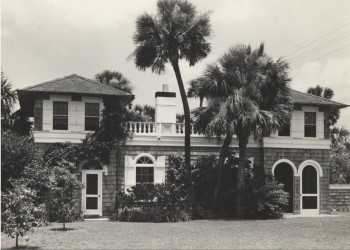 Abri. This Italian Renaissance Revival style house built around 1934 was originally owned by Broadway legend Lawrence Haynes. In his autobiography, “Joyous Life of a Singer”, Haynes attributes the name to a phrase used in World War I: “Vite a L’Abri,” which meant “Quick to the place where we are safe – where no harm can reach us.”
Abri. This Italian Renaissance Revival style house built around 1934 was originally owned by Broadway legend Lawrence Haynes. In his autobiography, “Joyous Life of a Singer”, Haynes attributes the name to a phrase used in World War I: “Vite a L’Abri,” which meant “Quick to the place where we are safe – where no harm can reach us.”

Atlantic Beach Elementary School. Built in 1939, the Atlantic Beach Elementary School has been a significant part of the community for many years. The most notable aspect of this building is its pink exterior with blue trim.
Captions for Images used in the article
1) “P-2509” – No caption
2) “840” – The Bull House
3) “3825” – Echidna
4) “1152” – L’Abri
5) “AB Students Celebrating May Day 5.9.1949” – Students Celebrating May Day at Atlantic Beach Elementary School, May 9, 1949.
 When discussing golf in the Beaches area, most will look towards Ponte Vedra Beach, particularly TPC Sawgrass and the annual PLAYERS Championship. However, Atlantic Beach has its own storied history in the world of golf.
When discussing golf in the Beaches area, most will look towards Ponte Vedra Beach, particularly TPC Sawgrass and the annual PLAYERS Championship. However, Atlantic Beach has its own storied history in the world of golf.
The Continental Hotel introduced the first golf courses to Atlantic Beach. While there was a large 18-hole course for guests to enjoy, a more unique course lay within the grounds, mere feet away from the train station and hotel itself. Famed golf course designer A. W. Tillinghast created a smaller 9-hole course called a Lilliputian Golf Course, which was a reference to the novel Gulliver’s Travels by Jonathan Swift. These courses were also connected to an early Atlantic Beach Country Club.
 The Selva Marina Country Club, a project initiated by Harcourt Bull, Jr., opened in 1958. Well received in the area, it featured a golf course designed by E. E. Smith and quickly grew to include tennis courts, a swimming pool, and a residential community. Selva Marina soon became an important and internationally recognized part of the community. It is best remembered as the birthplace of the Greater Jacksonville Open in 1965. Years later, this tournament became what is now known as the PLAYERS Championship. Playing host to many of golf’s greatest players including Arnold Palmer and Jack Nicklaus, Selva Marina created a name for itself in golf history. The Lady Jacksonville Open was also held at Selva Marina in 1975.
The Selva Marina Country Club, a project initiated by Harcourt Bull, Jr., opened in 1958. Well received in the area, it featured a golf course designed by E. E. Smith and quickly grew to include tennis courts, a swimming pool, and a residential community. Selva Marina soon became an important and internationally recognized part of the community. It is best remembered as the birthplace of the Greater Jacksonville Open in 1965. Years later, this tournament became what is now known as the PLAYERS Championship. Playing host to many of golf’s greatest players including Arnold Palmer and Jack Nicklaus, Selva Marina created a name for itself in golf history. The Lady Jacksonville Open was also held at Selva Marina in 1975.
 Today, the new Atlantic Beach Country Club continues Atlantic Beach’s golfing legacy at the site of old Selva Marina Country Club. In addition to the 6,815 square foot course redesigned by Erik Larsen, Atlantic Beach Country Club currently includes a neighborhood with 178 homesites, tennis courts, fitness facility, a junior Olympic swimming pool, and a 16,000 square foot clubhouse. Opened in January 2015, the revitalized 18-hole course was named as one of the nation’s Best New Courses by Golf Digest Magazine in 2014. The Web.com Tour Championship, part of the PGA TOUR, will be held at ABCC in Fall 2017.
Today, the new Atlantic Beach Country Club continues Atlantic Beach’s golfing legacy at the site of old Selva Marina Country Club. In addition to the 6,815 square foot course redesigned by Erik Larsen, Atlantic Beach Country Club currently includes a neighborhood with 178 homesites, tennis courts, fitness facility, a junior Olympic swimming pool, and a 16,000 square foot clubhouse. Opened in January 2015, the revitalized 18-hole course was named as one of the nation’s Best New Courses by Golf Digest Magazine in 2014. The Web.com Tour Championship, part of the PGA TOUR, will be held at ABCC in Fall 2017.
Captions for Images used in the article
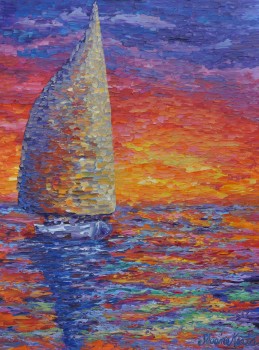 The winner of the 2017 Beaches Art Fest Poster Contest is Sloane Keats of Indialantic, Florida. Keats uses a layering technique and vivid colors to create a captivating texture in her paintings. Her entry “Alone” captured the essence of the event and its coastal community. “I bring a contemporary style to a traditional way to paint. Focusing on texture, color, pattern” said Keats.
The winner of the 2017 Beaches Art Fest Poster Contest is Sloane Keats of Indialantic, Florida. Keats uses a layering technique and vivid colors to create a captivating texture in her paintings. Her entry “Alone” captured the essence of the event and its coastal community. “I bring a contemporary style to a traditional way to paint. Focusing on texture, color, pattern” said Keats.
“We had so many great entries which bodes very well for the quality of the artwork that we’ll expect at this year’s festival” said Chris Hoffman, Executive Director of the Beaches Museum. “Making the event two days long has been a great move for everyone involved and we look forward to another successful weekend!”
A commemorative poster featuring the winning piece will be designed and available for purchase at the event. The deadline for artist applications for the Beaches Art Fest is July 15.
The 4th Annual Beaches Art Fest will be held Ocotber 14 and 15, 2017 at the Pablo Historical Park in Jacksonville Beach, FL. The Beaches Art Fest is presented by the Beaches Museum & History Park and Driftwood, Jacksonville Beach, FL and produced by Holiday Art Shows, St. Augustine, FL.
Call 904-241-5657 or click here for more information.
Under the cover of night, four Nazi spies departed from a submarine just off the coast of Florida. Upon landing, they concealed explosive materials and other items in the sand, and disappeared into the unsuspecting beachfront community with intentions of sabotaging American war efforts. While it may sound like another sensational and fictional World War II story from Hollywood, it happened during the late night hours of June 16, 1942 here on Ponte Vedra Beach.
Spies have long been utilized by opposing sides during wartime, and World War II was by no exception. Operations like these were already underway by the Nazis before the United States entered the war. After America declared war on Germany in December 1941 in the wake of Pearl Harbor, German interest in infiltrating the country increased greatly. By the summer of 1942, one such mission known as Operation Pastorius was already under way. The main objective of this mission was to create a crippling disruption of production of war materials in the United States; specifically aiming at aluminum and magnesium plants.
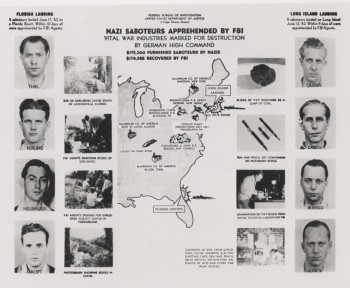
Armed with extensive training on sabotage, particularly in the creation and utilization of explosives, two groups of four men were sent to the Eastern coast of the United States. The first group, which landed in Long Island, NY, included George John Dasch, Ernest Peter Burger, Heinrich Harm Heinck and Richard Quirin; the second group, which landed in Ponte Vedra Beach, included Edward John Kerling, Werner Thiel, Hermann Otto Neubauer and Herbert Hans Haupt.
Ponte Vedra Beach was chosen as the site of the second landing as it was already known to the leader of that group, Kerling. In fact, all of these men had one very important factor in common: they had all lived for some time in the United States prior to this mission. They were chosen specifically for this reason since they were already familiar with American society and would be able to blend in easily among the crowds without arousing suspicion.
The second group arrived on the shores of Ponte Vedra Beach by submarine, also known as a U-boat, during the late night hours of June 16. The four spies were brought ashore in collapsible rubber boats, which were then rowed back to the submarine. Now left to their own devises, the four quickly hid their explosives and money in the sand among the palm trees and left with the intention of returning for these items within a few days.
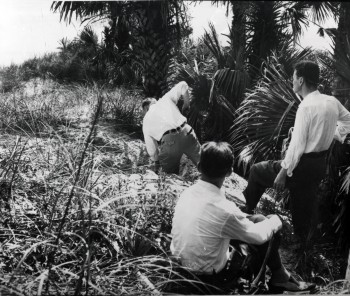
At left, FBI agents dig in the dunes near the saboteur’s landing site in Ponte Vedra Beach. Below, raw materials for making bombs discovered by the agents.
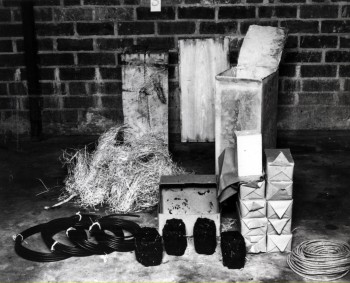
However, they did not count on being discovered before their return. Within a few days of landing at Long Beach, members of the group in New York were arrested and the plot was soon revealed. Though they had already left the state of Florida, the other spies were quickly captured and newspapers across the nation were soon filled with the trial regarding the fate of the spies. The trial concluded with death sentences for six of the saboteurs except for Dasch and Burger, who agreed to provide information in exchange for lesser sentences. Burger was given a life sentence in prison while Dasch received 30 years. He later went on to write a book about the story entitled Eight Spies Against America in 1959.
After the news was spread, beachfront security in the Beaches area was tightened, particularly in the strip of land where the saboteurs had landed. This incident and the sinking of the SS Gulfamerica oil tanker ensured a ban on lights along the shore front throughout the rest of the war.

The Mayport area has undergone many changes over the centuries. Even the St. Johns River, which has directly and indirectly brought about many of these changes, has been given several different names over the years. Among other titles, the Timucuan Indians were said to have called the river Welaka, or the River of Lakes, due to the many tributaries, lakes, and marshlands that are connected. Some of the first Spanish explorers who came to the area bestowed the river with the name of Rio de Corrientes, which translates to the River of Currents alluding to the turbulent and changing conditions at the entrance to the river between Mayport and Ft. George. French Huguenots around the same time began to call the same body of water the Riviere de Mai, or the River of May.
During Florida’s territory days from 1821 to 1845, the Mayport area was known as Hazard (sometimes written as Hazzard). This period of time contained many of Mayport’s milestones, including the construction of the first two lighthouses and the early days of the bar pilots. The name change to Mayport Mills in the 1840s is attributed to Kingsley B. Gibbs, the nephew of Zephaniah Kingsley of Kingsley Plantation in Ft. George. Gibbs opened a saw mill in Mayport, capitalizing on the lumber industry in the Beach area, a few years after purchasing Kingsley Plantation.
After the Civil War, Mayport became an area geared toward tourism and recreation, utilizing its oceanfront location and abundant fishing opportunities. It was not until 1909 that Mayport was officially deemed a city with plans to expand, which were likely ended by a large fire in 1917 that burned down several buildings.
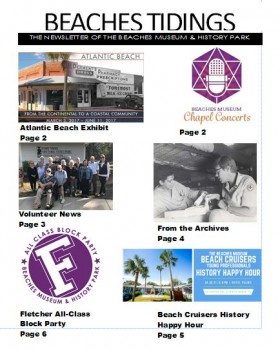
The Spring issue of Beaches Tidings, The Newsletter of the Beaches Museum & History Park, is now available. Click here to read this edition of Beach Tidings.